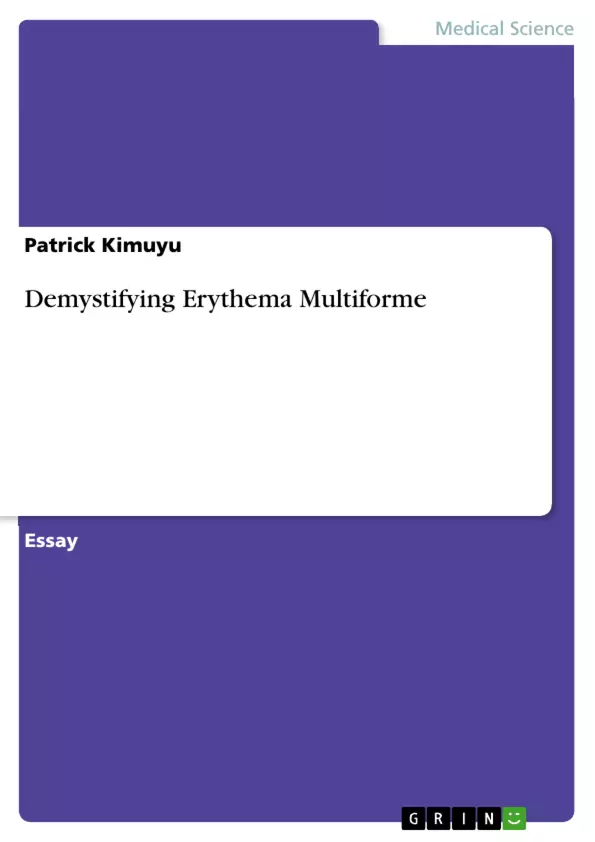Erythema multiforme is one of the rare dermatological disorders, and it is believed to be an hypersensitivity reaction to certain medications and infections. Lamoreux, Sternbach and Teresa (2006) describe the disorder as an acute, self-limited, as well as a recurring dermatological condition. This description is reaffirmed by Sokumbi and Wetter (2012) who cite certain medications, infections and other factors as triggers for type IV hypersensitivity reactions leading to the development of the main clinical features of erythema multiforme. In principle, this disorder derives its name from the characteristic appearance of the rash; ‘erythema’ redness; ‘multi’-many; and ‘forme’-shape (NHS, 2014). Initially, Erythema multiforme was considered to belong to a clinical spectrum of disorder that comprised of toxic epidermal necrolysis (TEN), Stevens-Johnson syndrome (SJS), erythema minor, and erythema major. However, advanced clinical descriptions of these conditions have been developed based on nature of the skin lesions, as well as the extent of epidermis detachment in which erythema multiforme and SJS are classified as different entities. Erythema multiforme spectrum comprises of erythema multiforme minor which is described as raised edematous papules exhibiting acral distribution, and erythema major which is characterized by acrally distributed edematous papules involving one or more mucous membranes (Bastuji-Garin et al., 1993). Overall, this paper provides a comprehensive overview on erythema multiforme.
Inhaltsverzeichnis (Table of Contents)
- Introduction
- Prevalence
- Etiology
- Infectious Agents
- Medications
- Contactants
- Other Etiological Factors
- Clinical Presentation
- Diagnosis
Zielsetzung und Themenschwerpunkte (Objectives and Key Themes)
This paper provides a comprehensive overview of Erythema Multiforme, a rare dermatological disorder. The paper explores the prevalence, etiology, clinical presentation, and diagnosis of this condition.
- Prevalence and demographic trends of Erythema Multiforme
- Infectious and medication-related causes of Erythema Multiforme
- The characteristic clinical features and target lesions of Erythema Multiforme
- The role of differential diagnosis in accurately identifying Erythema Multiforme
- The importance of recognizing Erythema Multiforme and its potential complications.
Zusammenfassung der Kapitel (Chapter Summaries)
The introduction to this paper provides a definition of Erythema Multiforme as an acute, self-limited, and recurring dermatological condition. It discusses the history of Erythema Multiforme and its classification within a spectrum of disorders. The prevalence section explores the estimated global prevalence of Erythema Multiforme, highlighting the lack of comprehensive epidemiological data in the United States. It also discusses demographic differences in incidence, particularly affecting young males and children.
The etiology chapter delves into the numerous factors that contribute to the onset of Erythema Multiforme. It categorizes these factors as infectious agents, medications, contactants, and other miscellaneous etiological factors. Each category is discussed in detail, identifying specific agents and their respective roles in triggering the disorder.
The clinical presentation section focuses on the characteristic features of Erythema Multiforme. It emphasizes the emergence of skin lesions, particularly the 'target' lesions, which result from keratinocyte necrosis. Additionally, it describes other clinical features like itchy skin, joint aches, mouth sores, fever, and potential complications.
The diagnosis chapter outlines the common diagnostic approaches used in identifying Erythema Multiforme. It highlights the importance of clinical features and patient history. The role of skin lesion biopsy and the Nikolsky sign is discussed, along with the challenges of misdiagnosis due to overlapping features with other disorders. Differential diagnosis is emphasized as a crucial aspect of accurate diagnosis.
Schlüsselwörter (Keywords)
Erythema Multiforme, dermatological disorder, hypersensitivity reaction, medications, infections, target lesions, clinical presentation, diagnosis, differential diagnosis, prevalence, epidemiology.
- Arbeit zitieren
- Patrick Kimuyu (Autor:in), 2018, Demystifying Erythema Multiforme, München, GRIN Verlag, https://www.hausarbeiten.de/document/412966


